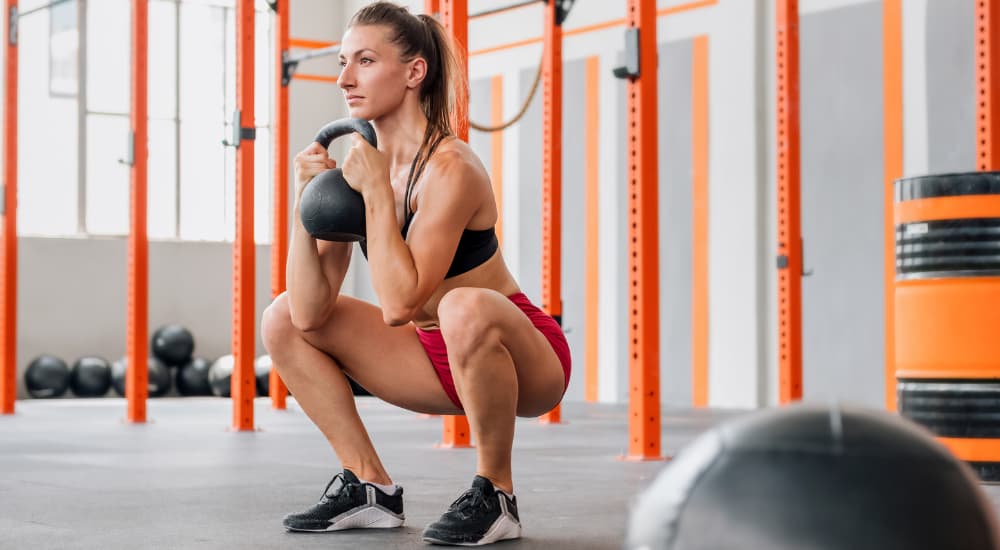
Categories
Incorporating Squats into Your Strength Training
Squats are often considered the cornerstone of any solid fitness regimen. They target multiple muscle groups simultaneously, from your glutes and hamstrings to your quadriceps and calves, extending their benefits to your core and back muscles. With this multi-target approach, squats enhance overall body strength, power, and muscular development.
But how can you incorporate squats effectively into your strength training routine to unlock these benefits? Whether you’re a beginner starting your strength training journey or an experienced lifter looking to optimise your workout, this will provide you with everything you need to know about squats. We look at different squat variations, give tips to perfect your form for maximum strength gains, suggest supplementary exercises, and offer strategies to overcome common challenges.
The Power of Squats
At first glance, the squat may seem like a simple, straightforward exercise. However, the power of squats lies in their complexity and the breadth of their impact on our bodies.
Squats as a Compound Exercise
Squats fall into the “compound exercises” category, a term used to describe movements that engage multiple muscle groups simultaneously. Unlike isolation exercises, which primarily target one specific muscle, compound exercises like squats demand more from your body. They stimulate many muscles, leading to a more efficient and effective workout.
Muscles Engaged When Performing Squats
When you perform a squat, you’re not just working your legs. The beauty of this exercise lies in its ability to engage many muscles. The primary movers are the quadriceps at the front of your thighs and the glutes, the muscles in your buttocks. These muscles do the brunt of the work as you lower your body and push back up.
However, squats also target the hamstrings at the back of your thighs, the adductors in your inner thighs, and the calves. They also engage your core muscles, including the rectus abdominis, obliques, and the erector spinae in your back. This total body engagement makes the squat a powerhouse exercise.
Increased Overall Strength and Muscular Development
With the simultaneous engagement of multiple muscles, squats offer an efficient way to increase overall body strength. As your muscles work together to perform the squat, they become stronger and more conditioned. Over time, this improves muscle tone, size, and power.
But the benefits of squats extend beyond muscle development. The compound nature of squats means they also increase your heart rate, leading to improved cardiovascular fitness. They also help improve balance, mobility, and coordination, improving physical fitness and health.
Types of Squats and Their Benefits in Strength Training
The squat may be a singular exercise, but its many variations make it a remarkably versatile addition to any strength training regimen. Each variant brings unique benefits and challenges, allowing you to adapt the squat to your fitness level and goals.
Different Types of Squats
Bodyweight Squats:
This is the most basic form of squat and a perfect starting point for beginners. It requires no equipment and is performed by lowering your body using the strength of your legs and core, then pushing back up to a standing position. They help develop foundational strength and mobility in the lower body and can be easily modified to suit different fitness levels.
Barbell Squats:
The barbell squat, often performed as a back squat with the barbell resting on the upper back or as a front squat with the barbell held in front of the body, introduces an additional weight component to the exercise. This increased resistance makes the exercise more challenging and can lead to significant strength and muscle gains. They also engage the core more intensively, promoting improved stability and balance.
Goblet Squats:
Named for how you hold the weight close to your chest (as if holding a large goblet), this type of squat uses a kettlebell or dumbbell and can help improve form and depth while still providing an effective lower-body workout. The front-loaded weight can help engage your core, improve your posture, and increase your overall squat depth.
Jump Squats:
This plyometric variation of the squat incorporates a jump at the end of the downward movement. This explosive addition increases the cardiovascular component of the exercise and enhances power and explosiveness. This makes them especially beneficial for athletes or anyone looking to improve their explosive strength.
Split Squats:
In this variant, one foot is placed in front of the other in a staggered stance. The split squat emphasises the quadriceps of the front leg and can help improve balance and unilateral strength. This can help identify and correct muscular imbalances while improving single-leg strength and stability.
Incorporate Squats into Your Strength Training
Squats are a flexible exercise that can be adapted and integrated into any strength training routine. However, how you incorporate them will depend on your training goals, experience level, and fitness routine.
Suggestions for Integrating Squats into Routines
For those new to strength training, starting with bodyweight squats can effectively build foundational strength. You could aim to incorporate sets of bodyweight squats into your routine 2-3 times a week.
More experienced gymers can incorporate barbell squats into their workout routine, preferably during a lower-or full-body workout day. Depending on your current strength and fitness levels, barbell squats could be performed 1-2 times weekly.
Goblet squats can be included on days focused on form and technique or as a warm-up exercise before moving on to heavier squats.
Jump squats can be incorporated on your cardio days or at the end of a strength workout as a burnout exercise to enhance your power and explosiveness.
Finally, split squats are a great addition to unilateral training days, focusing on working one side of the body at a time to improve muscular imbalances.
Adjusting Squat Variations and Intensity
If your goal is muscle building and strength, focus on weighted squats like barbell squats or goblet squats. Start with lighter weights to master the form, and gradually increase the weight as your strength improves.
For those looking to improve cardiovascular fitness or lose weight, bodyweight squats or jump squats performed at a higher rep range can be more beneficial.
Remember to progress at your own pace. Listen to your body, adjust the intensity, volume, and type of squat based on your comfort, and get some personal training advice if needed.
Perfecting Your Squat Form
The benefits of squats are only fully realised when performed with proper form. Misalignment or incorrect form can not only lessen the efficacy of the exercise but also lead to injuries. Here’s how to ensure you’re squatting correctly for maximum strength gains.
Correct Squat Form
1. Foot Placement:
Start with your feet shoulder-width apart; toes pointed slightly outward. This stance provides a solid base for the movement.
2. Engage Your Core:
Before you descend, take a deep breath and brace your core. This helps to maintain stability throughout the exercise.
3. Lower Your Body:
Bend at the hips and knees, lowering your body as if sitting back into a chair. Ensure your knees track over your toes but do not extend beyond them.
4. Maintain a Neutral Spine:
Keep your chest up and back straight. Your torso should lean slightly forward, but the back should remain neutral – avoid rounding or over-arching.
5. Check Your Depth:
Aim to lower your body until your hips are at least parallel with your knees. If mobility allows, you can squat deeper.
6. Push Back Up:
Drive through your heels to return to the starting position. Make sure to fully extend your hips and knees at the top of the movement.
Squat Technique: Part 1
Squat Technique: Part 2
Supplementing Your Squat Routine
While squats are a highly effective exercise, they are but one component of a well-rounded strength training program. Here, we’ll explore supplementary exercises, recovery strategies, and other crucial aspects of a balanced regimen that can enhance your squat performance and overall results.
To boost your squat performance, incorporate exercises that target similar muscle groups or work on areas of weakness.
- Hip Thrusts: These target the squat’s glutes and hamstrings, key muscles. Strengthening these muscles can help you generate more power during your squats.
- Lunges: Lunges work the quads, glutes, and hamstrings, similar to squats. They also challenge your balance and stability, essential for good squat form.
- Core Exercises: A strong core aids in maintaining proper form during squats. Planks, Russian twists, and bicycle crunches can help strengthen your core muscles.
Rest and recovery are just as important as the workout itself. After a heavy squat session, your muscles need time to repair and grow stronger. Ensure you allow adequate rest between exercises, get enough sleep, and incorporate active recovery techniques such as stretching and foam rolling.
Nutrition also plays a crucial role in muscle recovery and growth. A balanced diet rich in protein can aid in muscle repair, while carbohydrates replenish energy stores. Staying hydrated is equally important.
In addition to squats and the supplementary exercises mentioned, a comprehensive strength training program should also include the following:
- Upper Body Work: Exercises like bench presses, overhead presses, and pull-ups can ensure balanced upper body strength.
- Cardiovascular Exercise: Regular cardio, whether it’s running, swimming, or cycling, can help improve your endurance and overall fitness.
- Flexibility and Mobility Work: Incorporating regular stretching and mobility exercises can help keep your muscles limber and improve your range of motion, both of which aid in performing squats correctly.
By adopting a holistic approach to your strength training, you can ensure you’re maximising your squat performance and working towards overall fitness and health.
Related Articles
- 4 Tips to a Better Squat
- Squat to Improve Your Fitness
- A Deeper Look at The Squat
- The Surprising Benefits of Strength Training
- Home Workout – Press Ups and Body Weight Squats

